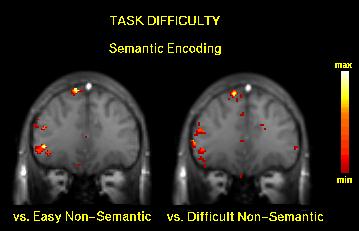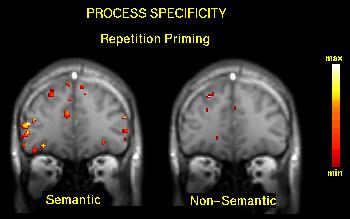

Prefrontal cortical function was examined during semantic encoding and repetition priming using functional magnetic resonance imaging (fMRI), a noninvasive technique for localizing regional changes in blood oxygenation, a correlate of neural activity. Words studied in a semantic (deep) encoding condition were better remembered than words studied in both easier and more difficult nonsemantic (shallow) encoding conditions, with difficulty indexed by response time. The left inferior prefrontal cortex (LIPC) (Brodmann's areas 45, 46, 47) showed increased activation during semantic encoding relative to nonsemantic encoding regardless of the relative difficulty of the nonsemantic encoding task. Therefore, LIPC activation appears to be related to semantic encoding and not task difficulty. Semantic encoding decisions are performed faster the second time words are presented. This represents semantic repetition priming, a facilitation in semantic processing for previously encoded words that is not dependent on intentional recollection. The same LIPC area activated during semantic encoding showed decreased activation during repeated semantic encoding relative to initial semantic encoding of the same words. This decrease in activation during repeated encoding was process specific; it occurred when words were semantically reprocessed but not when words were nonsemantically reprocessed. The results were apparent in both individual and averaged functional maps. These findings suggest that the LIPC is part of a semantic executive system that contributes to the on-line retrieval of semantic information.

